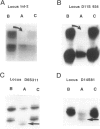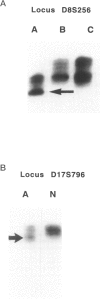Abstract
Loss of heterozygosity and microsatellite instability have been often reported in breast cancer and seldom in proliferative breast disease (PBD). DNA samples from microdissected PBD lesions, including papillomas (25 lesions), from 8 women were analyzed by polymerase chain reaction for loss of heterozygosity and microsatellite instability at 10 loci including INT-2 oncogene locus, D17S796 (the p53 gene region), and D17S579 (in the region of the BRCA-1 gene). In a patient, five loci with microsatellite instability and two loci with loss of heterozygosity were identified in one papilloma with florid hyperplasia and atypia, and 10 other PBD lesions were negative for genetic alteration (GA) and atypia. Three loci with microsatellite instability were identified in another PBD lesion without atypia, whereas another lesion from this second patient had minimal atypia without GAs. These two patients have been well for more than 20 years. No other patient, including a woman developing cancer, had GAs. We detected GAs in PBD (25% of women, 8% of lesions). Incomplete correlation between GAs and anatomic atypia was suggested. It seems evident that several GAs in PBD lesions may not indicate clinically meaningful premalignancy for remaining breast.
Full text
PDF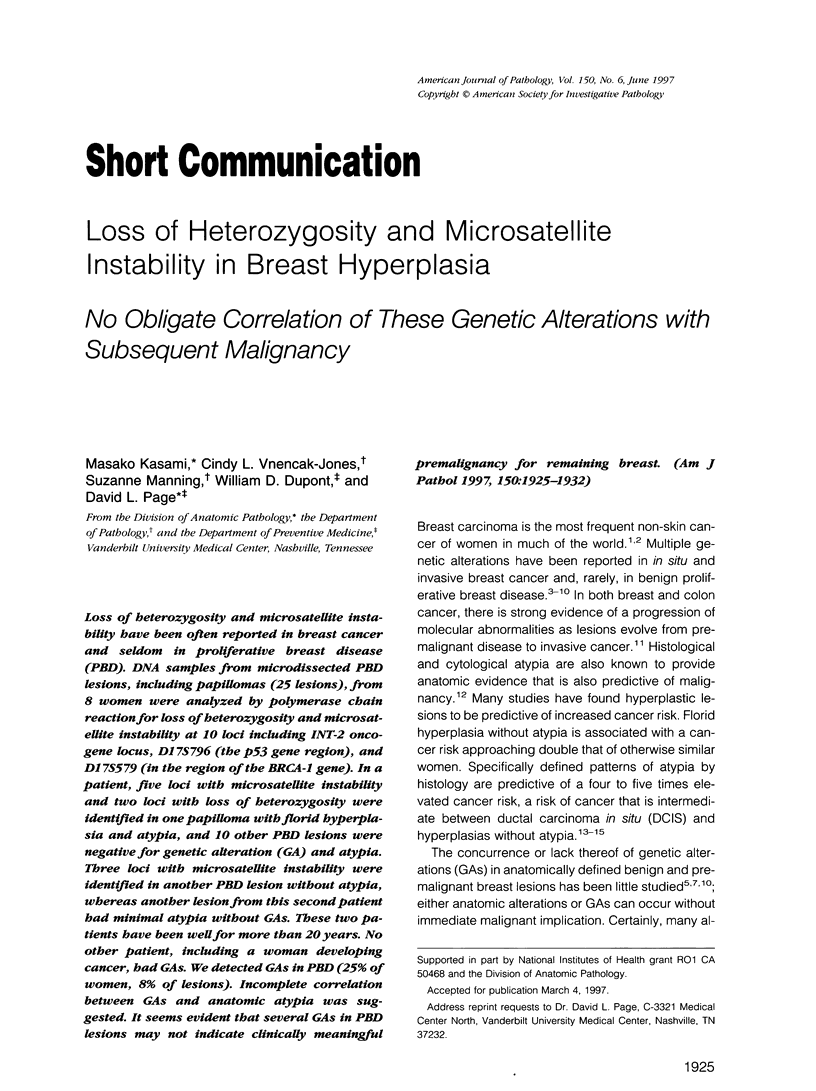
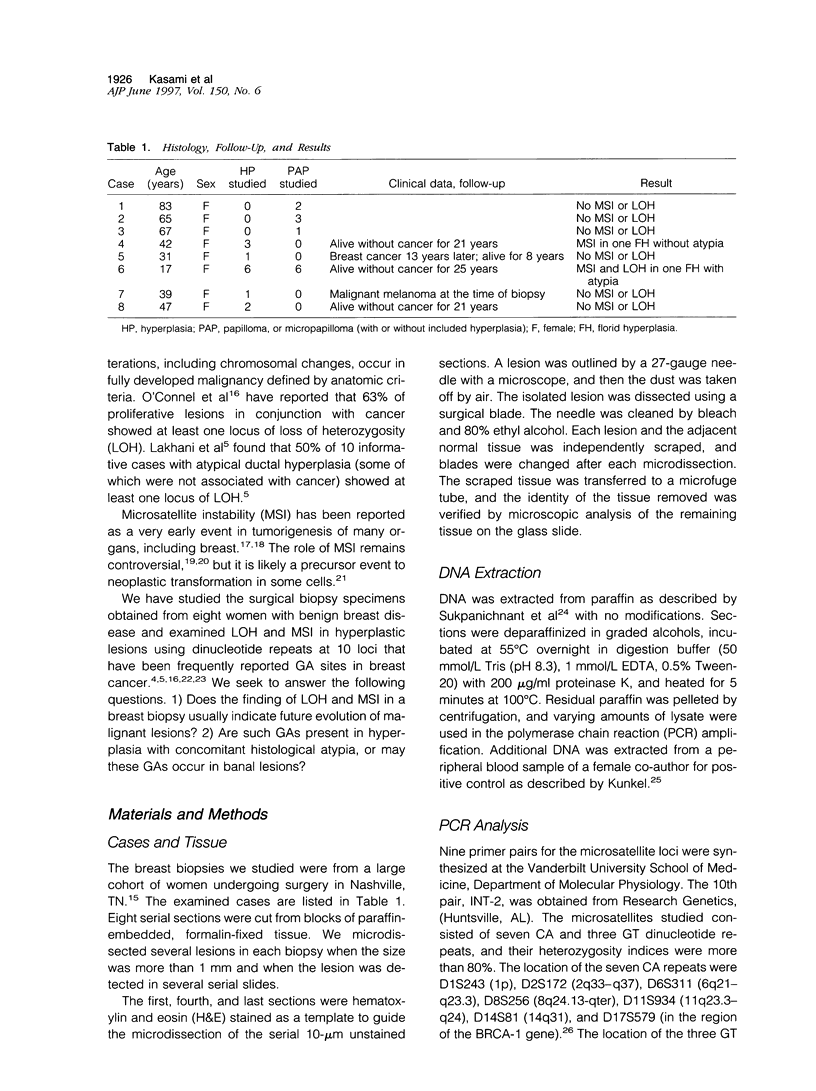
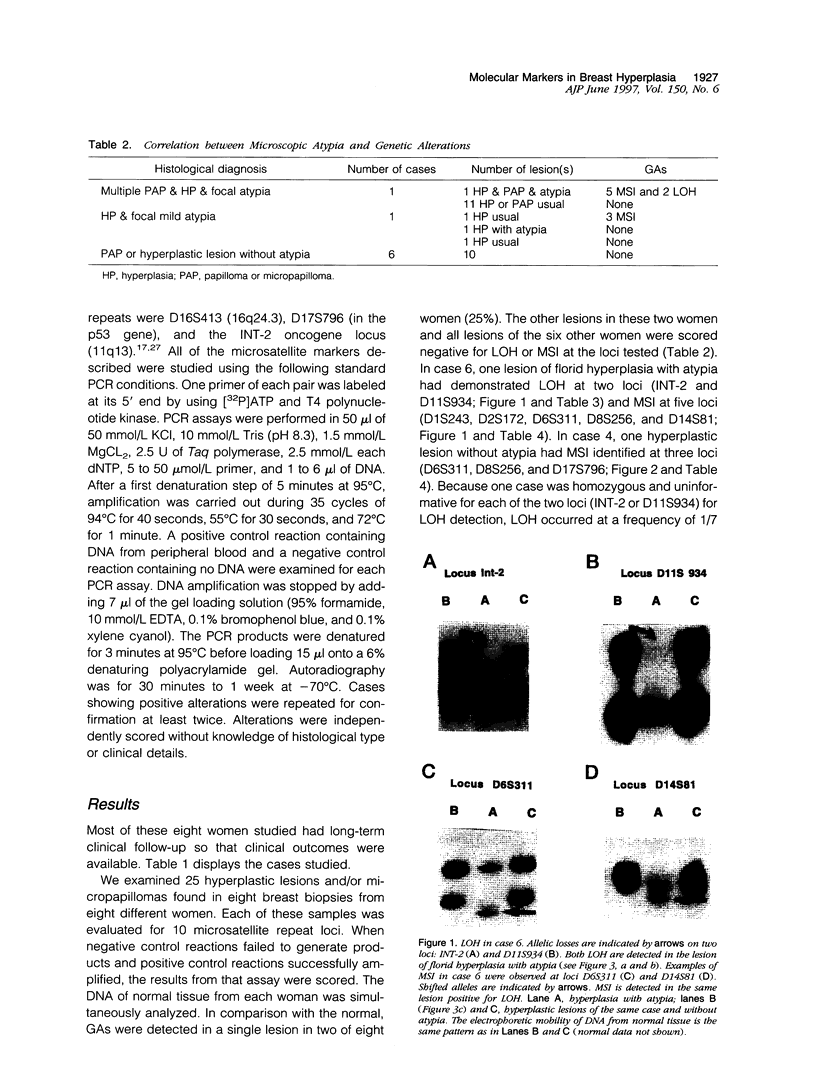
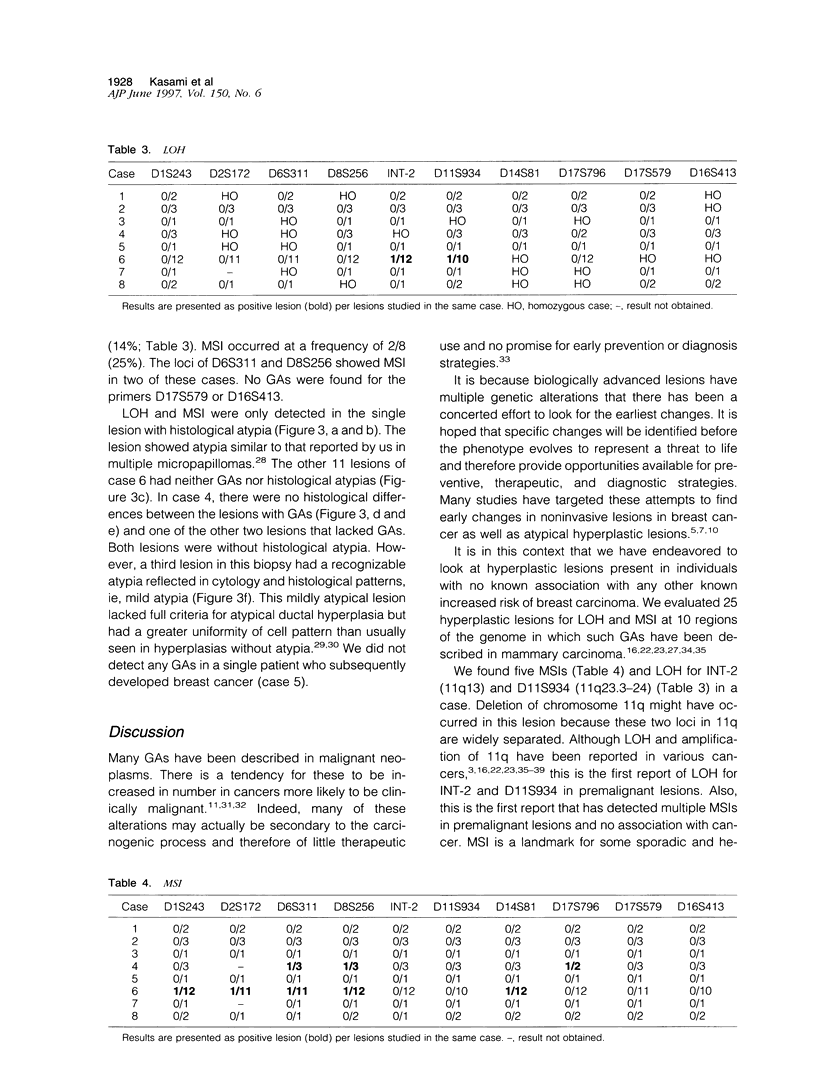
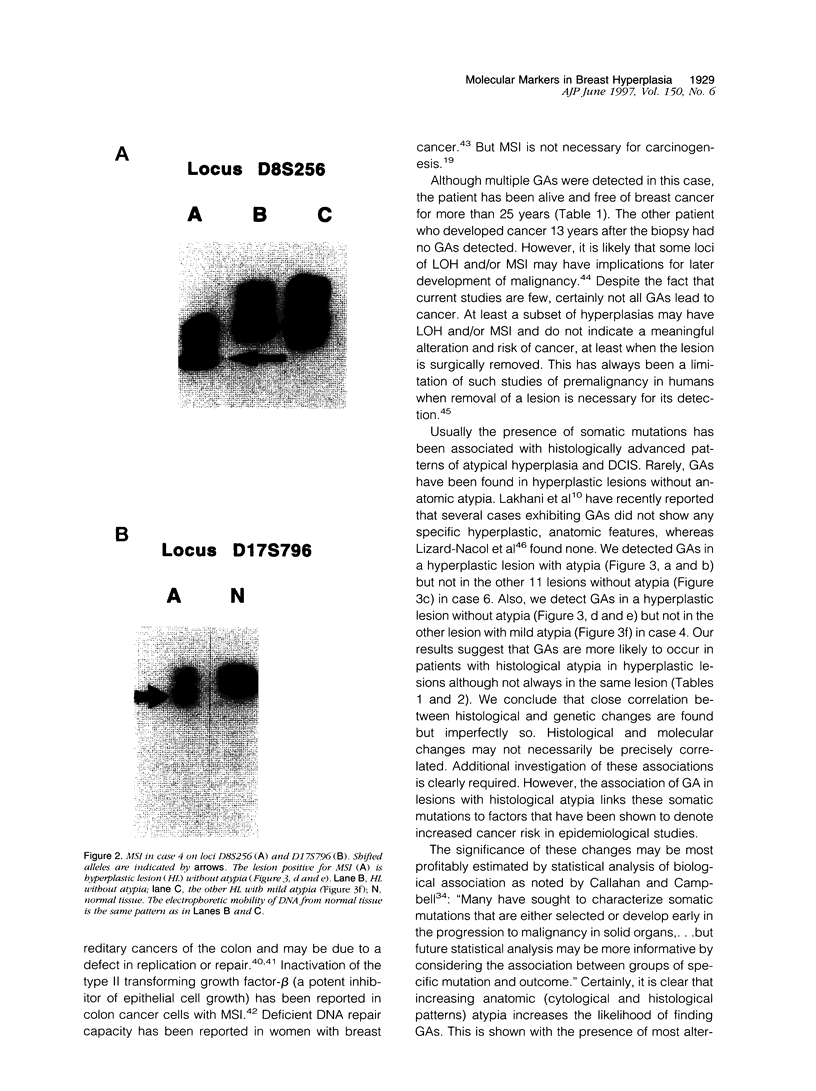
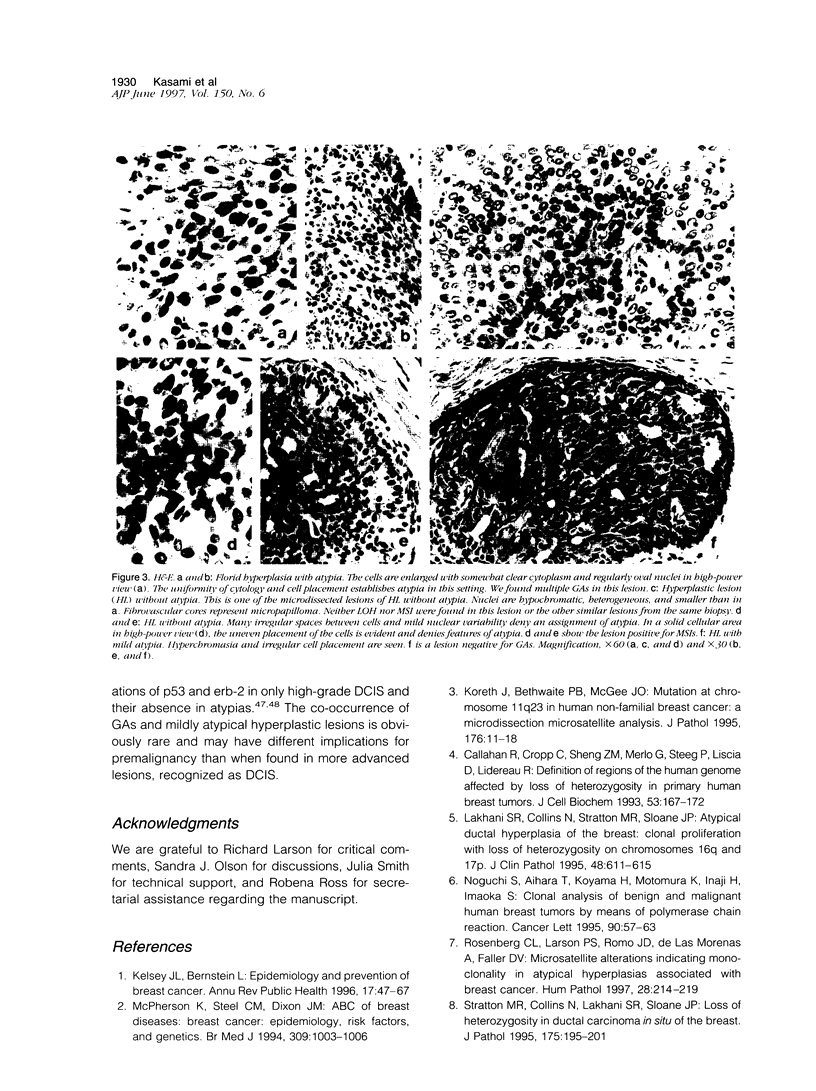
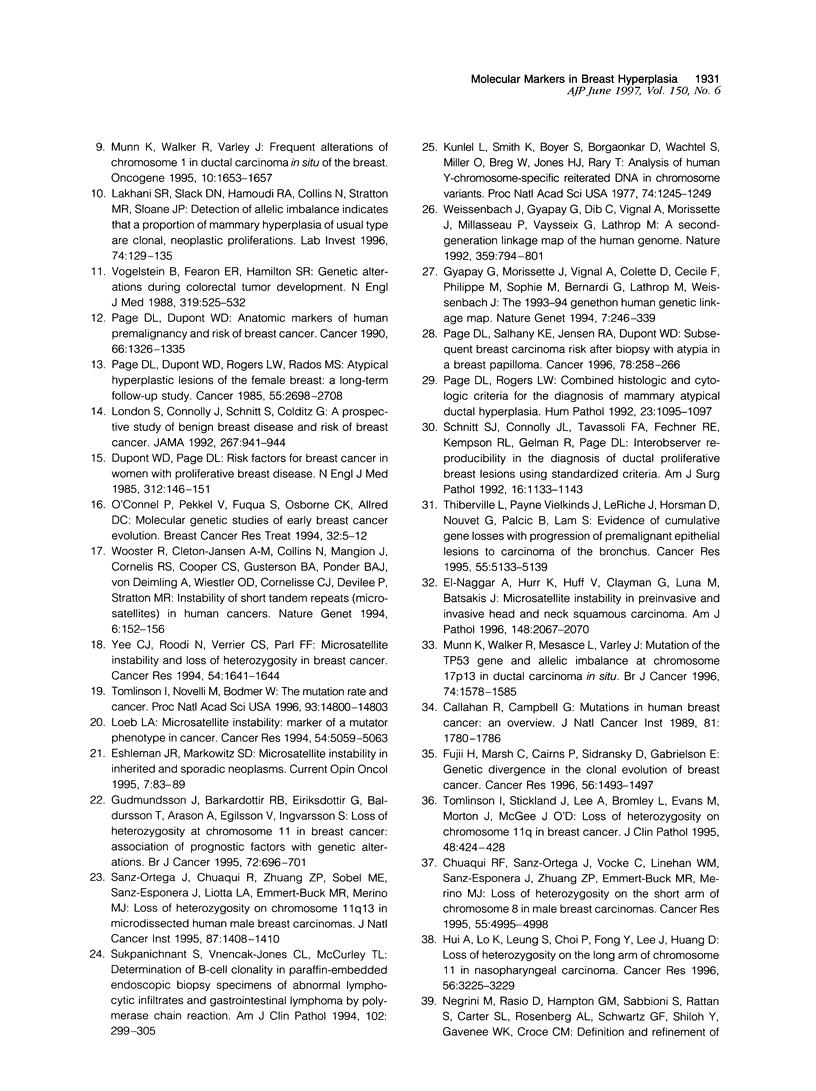
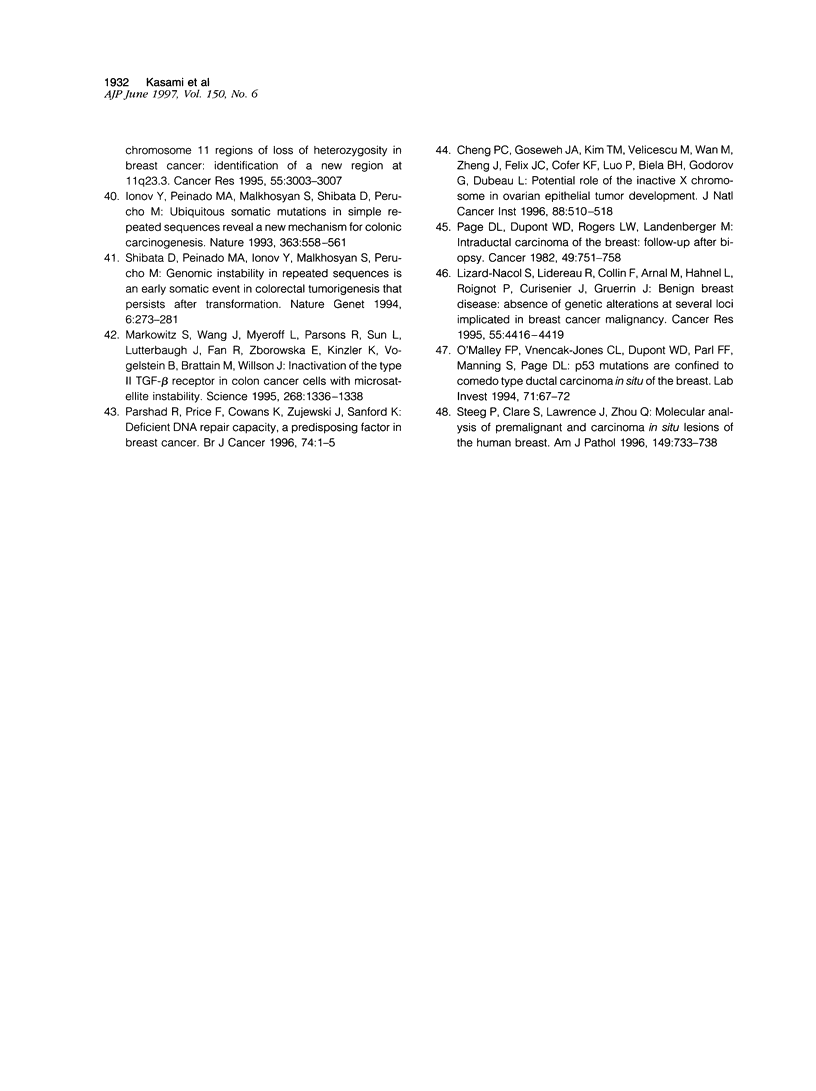
Images in this article
Selected References
These references are in PubMed. This may not be the complete list of references from this article.
- Callahan R., Campbell G. Mutations in human breast cancer: an overview. J Natl Cancer Inst. 1989 Dec 6;81(23):1780–1786. doi: 10.1093/jnci/81.23.1780. [DOI] [PubMed] [Google Scholar]
- Callahan R., Cropp C., Sheng Z. M., Merlo G., Steeg P., Liscia D., Lidereau R. Definition of regions of the human genome affected by loss of heterozygosity in primary human breast tumors. J Cell Biochem Suppl. 1993;17G:167–172. doi: 10.1002/jcb.240531131. [DOI] [PubMed] [Google Scholar]
- Cheng P. C., Gosewehr J. A., Kim T. M., Velicescu M., Wan M., Zheng J., Felix J. C., Cofer K. F., Luo P., Biela B. H. Potential role of the inactivated X chromosome in ovarian epithelial tumor development. J Natl Cancer Inst. 1996 Apr 17;88(8):510–518. doi: 10.1093/jnci/88.8.510. [DOI] [PubMed] [Google Scholar]
- Chuaqui R. F., Sanz-Ortega J., Vocke C., Linehan W. M., Sanz-Esponera J., Zhuang Z., Emmert-Buck M. R., Merino M. J. Loss of heterozygosity on the short arm of chromosome 8 in male breast carcinomas. Cancer Res. 1995 Nov 1;55(21):4995–4998. [PubMed] [Google Scholar]
- Dupont W. D., Page D. L. Risk factors for breast cancer in women with proliferative breast disease. N Engl J Med. 1985 Jan 17;312(3):146–151. doi: 10.1056/NEJM198501173120303. [DOI] [PubMed] [Google Scholar]
- El-Naggar A. K., Hurr K., Huff V., Clayman G. L., Luna M. A., Batsakis J. G. Microsatellite instability in preinvasive and invasive head and neck squamous carcinoma. Am J Pathol. 1996 Jun;148(6):2067–2072. [PMC free article] [PubMed] [Google Scholar]
- Eshleman J. R., Markowitz S. D. Microsatellite instability in inherited and sporadic neoplasms. Curr Opin Oncol. 1995 Jan;7(1):83–89. [PubMed] [Google Scholar]
- Fujii H., Marsh C., Cairns P., Sidransky D., Gabrielson E. Genetic divergence in the clonal evolution of breast cancer. Cancer Res. 1996 Apr 1;56(7):1493–1497. [PubMed] [Google Scholar]
- Gudmundsson J., Barkardottir R. B., Eiriksdottir G., Baldursson T., Arason A., Egilsson V., Ingvarsson S. Loss of heterozygosity at chromosome 11 in breast cancer: association of prognostic factors with genetic alterations. Br J Cancer. 1995 Sep;72(3):696–701. doi: 10.1038/bjc.1995.396. [DOI] [PMC free article] [PubMed] [Google Scholar]
- Gyapay G., Morissette J., Vignal A., Dib C., Fizames C., Millasseau P., Marc S., Bernardi G., Lathrop M., Weissenbach J. The 1993-94 Généthon human genetic linkage map. Nat Genet. 1994 Jun;7(2 Spec No):246–339. doi: 10.1038/ng0694supp-246. [DOI] [PubMed] [Google Scholar]
- Hui A. B., Lo K. W., Leung S. F., Choi P. H., Fong Y., Lee J. C., Huang D. P. Loss of heterozygosity on the long arm of chromosome 11 in nasopharyngeal carcinoma. Cancer Res. 1996 Jul 15;56(14):3225–3229. [PubMed] [Google Scholar]
- Ionov Y., Peinado M. A., Malkhosyan S., Shibata D., Perucho M. Ubiquitous somatic mutations in simple repeated sequences reveal a new mechanism for colonic carcinogenesis. Nature. 1993 Jun 10;363(6429):558–561. doi: 10.1038/363558a0. [DOI] [PubMed] [Google Scholar]
- Kelsey J. L., Bernstein L. Epidemiology and prevention of breast cancer. Annu Rev Public Health. 1996;17:47–67. doi: 10.1146/annurev.pu.17.050196.000403. [DOI] [PubMed] [Google Scholar]
- Koreth J., Bethwaite P. B., McGee J. O. Mutation at chromosome 11q23 in human non-familial breast cancer: a microdissection microsatellite analysis. J Pathol. 1995 May;176(1):11–18. doi: 10.1002/path.1711760104. [DOI] [PubMed] [Google Scholar]
- Kunkel L. M., Smith K. D., Boyer S. H., Borgaonkar D. S., Wachtel S. S., Miller O. J., Breg W. R., Jones H. W., Jr, Rary J. M. Analysis of human Y-chromosome-specific reiterated DNA in chromosome variants. Proc Natl Acad Sci U S A. 1977 Mar;74(3):1245–1249. doi: 10.1073/pnas.74.3.1245. [DOI] [PMC free article] [PubMed] [Google Scholar]
- Lakhani S. R., Collins N., Stratton M. R., Sloane J. P. Atypical ductal hyperplasia of the breast: clonal proliferation with loss of heterozygosity on chromosomes 16q and 17p. J Clin Pathol. 1995 Jul;48(7):611–615. doi: 10.1136/jcp.48.7.611. [DOI] [PMC free article] [PubMed] [Google Scholar]
- Lakhani S. R., Slack D. N., Hamoudi R. A., Collins N., Stratton M. R., Sloane J. P. Detection of allelic imbalance indicates that a proportion of mammary hyperplasia of usual type are clonal, neoplastic proliferations. Lab Invest. 1996 Jan;74(1):129–135. [PubMed] [Google Scholar]
- Lizard-Nacol S., Lidereau R., Collin F., Arnal M., Hahnel L., Roignot P., Cuisenier J., Guerrin J. Benign breast disease: absence of genetic alterations at several loci implicated in breast cancer malignancy. Cancer Res. 1995 Oct 1;55(19):4416–4419. [PubMed] [Google Scholar]
- Loeb L. A. Microsatellite instability: marker of a mutator phenotype in cancer. Cancer Res. 1994 Oct 1;54(19):5059–5063. [PubMed] [Google Scholar]
- London S. J., Connolly J. L., Schnitt S. J., Colditz G. A. A prospective study of benign breast disease and the risk of breast cancer. JAMA. 1992 Feb 19;267(7):941–944. [PubMed] [Google Scholar]
- Markowitz S., Wang J., Myeroff L., Parsons R., Sun L., Lutterbaugh J., Fan R. S., Zborowska E., Kinzler K. W., Vogelstein B. Inactivation of the type II TGF-beta receptor in colon cancer cells with microsatellite instability. Science. 1995 Jun 2;268(5215):1336–1338. doi: 10.1126/science.7761852. [DOI] [PubMed] [Google Scholar]
- McPherson K., Steel C. M., Dixon J. M. ABC of breast diseases. Breast cancer--epidemiology, risk factors and genetics. BMJ. 1994 Oct 15;309(6960):1003–1006. doi: 10.1136/bmj.309.6960.1003. [DOI] [PMC free article] [PubMed] [Google Scholar]
- Munn K. E., Walker R. A., Menasce L., Varley J. M. Mutation of the TP53 gene and allelic imbalance at chromosome 17p13 in ductal carcinoma in situ. Br J Cancer. 1996 Nov;74(10):1578–1585. doi: 10.1038/bjc.1996.592. [DOI] [PMC free article] [PubMed] [Google Scholar]
- Munn K. E., Walker R. A., Varley J. M. Frequent alterations of chromosome 1 in ductal carcinoma in situ of the breast. Oncogene. 1995 Apr 20;10(8):1653–1657. [PubMed] [Google Scholar]
- Noguchi S., Aihara T., Koyama H., Motomura K., Inaji H., Imaoka S. Clonal analysis of benign and malignant human breast tumors by means of polymerase chain reaction. Cancer Lett. 1995 Mar 23;90(1):57–63. doi: 10.1016/0304-3835(94)03678-c. [DOI] [PubMed] [Google Scholar]
- O'Connell P., Pekkel V., Fuqua S., Osborne C. K., Allred D. C. Molecular genetic studies of early breast cancer evolution. Breast Cancer Res Treat. 1994;32(1):5–12. doi: 10.1007/BF00666201. [DOI] [PubMed] [Google Scholar]
- O'Malley F. P., Vnencak-Jones C. L., Dupont W. D., Parl F., Manning S., Page D. L. p53 mutations are confined to the comedo type ductal carcinoma in situ of the breast. Immunohistochemical and sequencing data. Lab Invest. 1994 Jul;71(1):67–72. [PubMed] [Google Scholar]
- Page D. L., Dupont W. D. Anatomic markers of human premalignancy and risk of breast cancer. Cancer. 1990 Sep 15;66(6 Suppl):1326–1335. doi: 10.1002/1097-0142(19900915)66:14+<1326::aid-cncr2820661405>3.0.co;2-p. [DOI] [PubMed] [Google Scholar]
- Page D. L., Dupont W. D., Rogers L. W., Landenberger M. Intraductal carcinoma of the breast: follow-up after biopsy only. Cancer. 1982 Feb 15;49(4):751–758. doi: 10.1002/1097-0142(19820215)49:4<751::aid-cncr2820490426>3.0.co;2-y. [DOI] [PubMed] [Google Scholar]
- Page D. L., Dupont W. D., Rogers L. W., Rados M. S. Atypical hyperplastic lesions of the female breast. A long-term follow-up study. Cancer. 1985 Jun 1;55(11):2698–2708. doi: 10.1002/1097-0142(19850601)55:11<2698::aid-cncr2820551127>3.0.co;2-a. [DOI] [PubMed] [Google Scholar]
- Page D. L., Rogers L. W. Combined histologic and cytologic criteria for the diagnosis of mammary atypical ductal hyperplasia. Hum Pathol. 1992 Oct;23(10):1095–1097. doi: 10.1016/0046-8177(92)90026-y. [DOI] [PubMed] [Google Scholar]
- Page D. L., Salhany K. E., Jensen R. A., Dupont W. D. Subsequent breast carcinoma risk after biopsy with atypia in a breast papilloma. Cancer. 1996 Jul 15;78(2):258–266. doi: 10.1002/(SICI)1097-0142(19960715)78:2<258::AID-CNCR11>3.0.CO;2-V. [DOI] [PubMed] [Google Scholar]
- Parshad R., Price F. M., Bohr V. A., Cowans K. H., Zujewski J. A., Sanford K. K. Deficient DNA repair capacity, a predisposing factor in breast cancer. Br J Cancer. 1996 Jul;74(1):1–5. doi: 10.1038/bjc.1996.307. [DOI] [PMC free article] [PubMed] [Google Scholar]
- Rosenberg C. L., Larson P. S., Romo J. D., De Las Morenas A., Faller D. V. Microsatellite alterations indicating monoclonality in atypical hyperplasias associated with breast cancer. Hum Pathol. 1997 Feb;28(2):214–219. doi: 10.1016/s0046-8177(97)90109-x. [DOI] [PubMed] [Google Scholar]
- Sanz-Ortega J., Chuaqui R., Zhuang Z., Sobel M. E., Sanz-Esponera J., Liotta L. A., Emmert-Buck M. R., Merino M. J. Loss of heterozygosity on chromosome 11q13 in microdissected human male breast carcinomas. J Natl Cancer Inst. 1995 Sep 20;87(18):1408–1410. doi: 10.1093/jnci/87.18.1408. [DOI] [PubMed] [Google Scholar]
- Schnitt S. J., Connolly J. L., Tavassoli F. A., Fechner R. E., Kempson R. L., Gelman R., Page D. L. Interobserver reproducibility in the diagnosis of ductal proliferative breast lesions using standardized criteria. Am J Surg Pathol. 1992 Dec;16(12):1133–1143. doi: 10.1097/00000478-199212000-00001. [DOI] [PubMed] [Google Scholar]
- Shibata D., Peinado M. A., Ionov Y., Malkhosyan S., Perucho M. Genomic instability in repeated sequences is an early somatic event in colorectal tumorigenesis that persists after transformation. Nat Genet. 1994 Mar;6(3):273–281. doi: 10.1038/ng0394-273. [DOI] [PubMed] [Google Scholar]
- Steeg P. S., Clare S. E., Lawrence J. A., Zhou Q. Molecular analysis of premalignant and carcinoma in situ lesions of the human breast. Am J Pathol. 1996 Sep;149(3):733–738. [PMC free article] [PubMed] [Google Scholar]
- Stratton M. R., Collins N., Lakhani S. R., Sloane J. P. Loss of heterozygosity in ductal carcinoma in situ of the breast. J Pathol. 1995 Feb;175(2):195–201. doi: 10.1002/path.1711750207. [DOI] [PubMed] [Google Scholar]
- Sukpanichnant S., Vnencak-Jones C. L., McCurley T. L. Determination of B-cell clonality in paraffin-embedded endoscopic biopsy specimens of abnormal lymphocytic infiltrates and gastrointestinal lymphoma by polymerase chain reaction. Am J Clin Pathol. 1994 Sep;102(3):299–305. doi: 10.1093/ajcp/102.3.299. [DOI] [PubMed] [Google Scholar]
- Thiberville L., Payne P., Vielkinds J., LeRiche J., Horsman D., Nouvet G., Palcic B., Lam S. Evidence of cumulative gene losses with progression of premalignant epithelial lesions to carcinoma of the bronchus. Cancer Res. 1995 Nov 15;55(22):5133–5139. [PubMed] [Google Scholar]
- Tomlinson I. P., Novelli M. R., Bodmer W. F. The mutation rate and cancer. Proc Natl Acad Sci U S A. 1996 Dec 10;93(25):14800–14803. doi: 10.1073/pnas.93.25.14800. [DOI] [PMC free article] [PubMed] [Google Scholar]
- Tomlinson I. P., Strickland J. E., Lee A. S., Bromley L., Evans M. F., Morton J., McGee J. O. Loss of heterozygosity on chromosome 11 q in breast cancer. J Clin Pathol. 1995 May;48(5):424–428. doi: 10.1136/jcp.48.5.424. [DOI] [PMC free article] [PubMed] [Google Scholar]
- Vogelstein B., Fearon E. R., Hamilton S. R., Kern S. E., Preisinger A. C., Leppert M., Nakamura Y., White R., Smits A. M., Bos J. L. Genetic alterations during colorectal-tumor development. N Engl J Med. 1988 Sep 1;319(9):525–532. doi: 10.1056/NEJM198809013190901. [DOI] [PubMed] [Google Scholar]
- Weissenbach J., Gyapay G., Dib C., Vignal A., Morissette J., Millasseau P., Vaysseix G., Lathrop M. A second-generation linkage map of the human genome. Nature. 1992 Oct 29;359(6398):794–801. doi: 10.1038/359794a0. [DOI] [PubMed] [Google Scholar]
- Wooster R., Cleton-Jansen A. M., Collins N., Mangion J., Cornelis R. S., Cooper C. S., Gusterson B. A., Ponder B. A., von Deimling A., Wiestler O. D. Instability of short tandem repeats (microsatellites) in human cancers. Nat Genet. 1994 Feb;6(2):152–156. doi: 10.1038/ng0294-152. [DOI] [PubMed] [Google Scholar]
- Yee C. J., Roodi N., Verrier C. S., Parl F. F. Microsatellite instability and loss of heterozygosity in breast cancer. Cancer Res. 1994 Apr 1;54(7):1641–1644. [PubMed] [Google Scholar]



